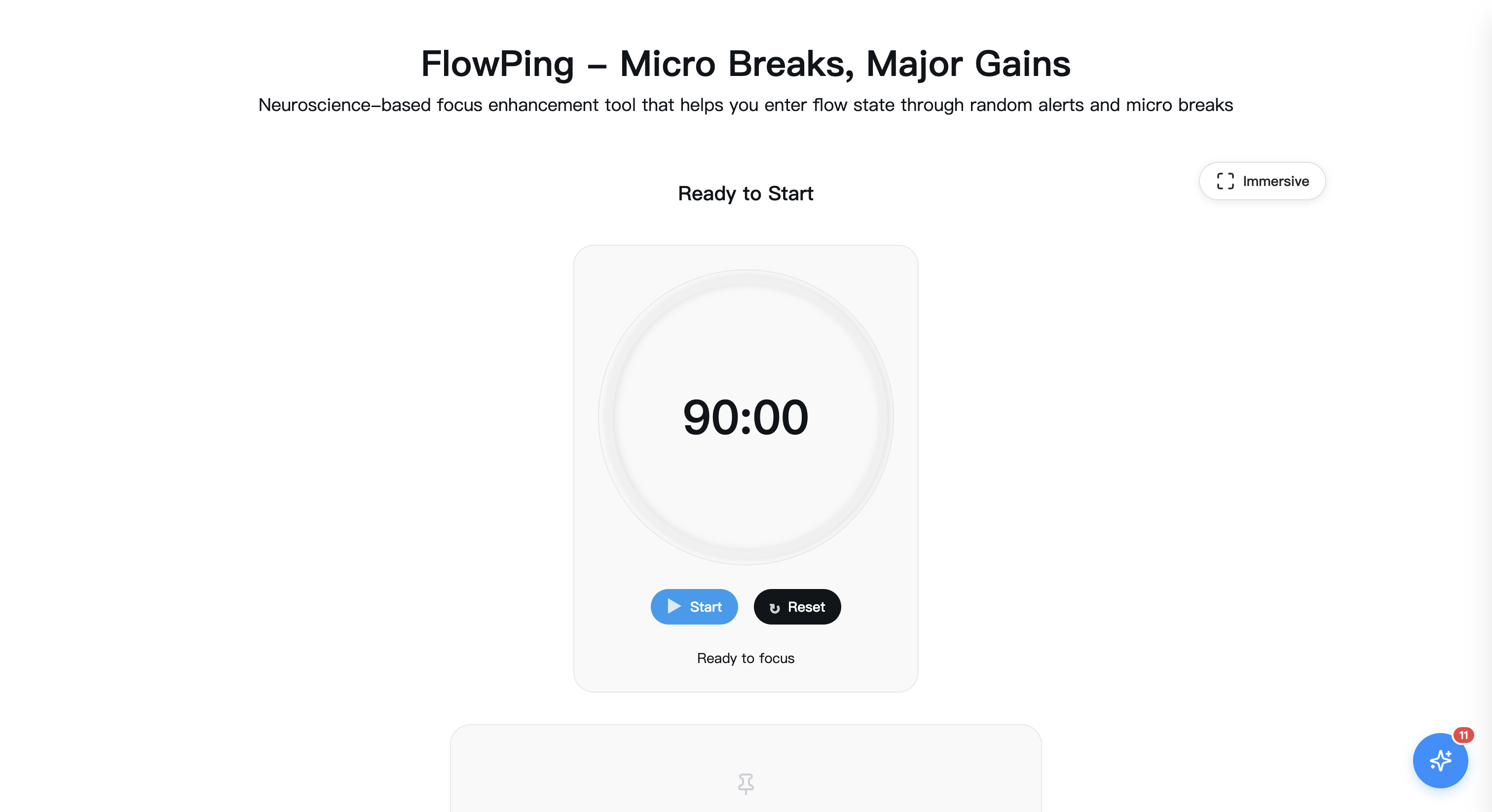- FlowPing Learning Hub
- FlowPing Delayed Note-Taking: The Science and Practice

FlowPing Delayed Note-Taking: The Science and Practice
Discover how FlowPing's random alerts and micro breaks turn delayed note-taking into a neuroscience-backed learning system.

The Delayed Note-Taking Method: A Counterintuitive Strategy to Revolutionize How You Learn
Have you ever felt that even after taking meticulous notes, the information just seems to pass through your brain without sticking? Do you find yourself becoming more and more dependent on your notes, only to draw a blank the moment you close your notebook?
If you answered yes, you might be caught in the "ineffective note-taking" trap. Today, let's explore a game-changing learning method: The Delayed Note-Taking Method. This approach will show you how doing less—and even delaying your note-taking—can lead to truly effective learning and long-term memory.

What is Delayed Note-Taking?
Simply put, the delayed note-taking method is the strategy of intentionally waiting for a period of time after reading or learning something before you write it down.
Here’s how it works: you read a unit of information, like a few pages or a chapter. When you're done, instead of immediately picking up a pen, you spend a few minutes mentally recalling what you just read. Then, you jot down only a few keywords to represent the core ideas. Later, after you've finished your entire study session or perhaps at the end of the day, you use these keywords to create a structured, comprehensive set of notes.
This seemingly "lazy" method is backed by some serious science. It forces your brain to work harder, which in turn helps you truly internalize information and make it your own.
Why Is This Method So Effective? The Three Scientific Principles Behind It
To understand why delayed note-taking works wonders, we need to look at how our brains learn and remember.
Principle #1: It Works With Your Brain's Natural Tendency to Conserve Energy
Our brain is an incredibly efficient organ, always looking for ways to save energy. It has a habit: if a piece of information is recorded by an external tool (like being written on paper or saved on a computer), the brain considers it "safely archived" and doesn't need to expend energy to remember it. In cognitive psychology, this is known as Cognitive Offloading.
So, when you get into the habit of taking notes while you learn, the knowledge is likely being stored in your notebook, not in your head. The delayed note-taking method counteracts this by preventing your brain from easily offloading information. This forces it to work harder to encode and store the information, leading to much deeper retention.
Principle #2: It Artificially Creates "Neural Replay" for Memory Consolidation
A 2020 study in Cell Reports found that when people take short breaks, their brains "replay" what they've just learned at 10 to 20 times the normal speed. This is a critical process for consolidating memory.
The delayed note-taking method cleverly leverages this mechanism. Those few minutes you spend recalling a chapter after reading it are actively guiding your brain to perform this neural replay. This process not only helps you filter out the most important information but also significantly strengthens the stability of the memory. Shifting from passive reception to active recall is the golden moment for converting short-term memories into long-term ones.
Principle #3: It Counteracts the Information Overload Caused by the "Novelty Effect"
When you're reading, it often feels like "everything is important," and you want to write it all down. This is the result of new information stimulating your brain's reward circuit, releasing dopamine, and creating a sense of "craving" and "excitement."
However, the true goal of learning isn't to collect information but to build a knowledge system. The delayed note-taking method introduces a "cooling-off period" that effectively counteracts this novelty-driven greed. After some time has passed and the initial excitement has faded, you can more rationally and clearly judge what's truly essential and needs to be deeply understood, and what's just supplementary. This helps you invest your precious mental energy in processing the most critical knowledge.
How to Practice Delayed Note-Taking
The theory sounds great, but how do you apply it to your daily learning? The key is to establish a "Read-Recall-Record" cycle. However, doing this manually often presents a few challenges:
- How do you define a "learning unit"? Deciding to stop after a chapter can interrupt your flow and is hard to stick with.
- How do you trigger "active recall"? When you're immersed in reading, it's easy to forget to stop and recall, missing that golden opportunity for memory consolidation.
- How do you manage the overall rhythm? Knowing when to do a small cycle versus a larger review session requires careful planning and self-discipline.
These challenges are precisely what makes delayed note-taking difficult to implement in practice. Fortunately, the right tool can help you overcome these obstacles and put the theory into practice seamlessly.
Meet FlowPing: Your Supercharger for Delayed Note-Taking
As you put this into practice, you might run into some specific questions: How long should a "reading unit" be? How can you ensure your "brief recall" isn't interrupted? How do you integrate this method into a long-term study plan?
This is exactly where FlowPing can help. FlowPing is more than just a notification tool; it's a focus training system that pairs perfectly with the delayed note-taking method.

Define "Learning Units" with Random Pings
You no longer need to stress about "finishing the chapter before taking a break." In FlowPing, you can set a random ping to go off every 5-10 minutes. When the ping sounds, it signals the end of an "immersive reading" unit. This creates a more flexible, low-pressure way to read.
Use "Micro-Breaks" for "Active Recall"
When FlowPing's ping sounds, it's followed by a 10-second micro-break. These 10 seconds are the perfect opportunity to practice the "brief recall and keyword extraction" part of the delayed note-taking method. Use this short gap to quickly run through what you just read and jot down one or two of the most important keywords. It's a fast, efficient process that fits perfectly into your learning flow.
Manage Your Overall Learning Rhythm with "Focus Cycles"
You can utilize FlowPing's 90-minute focus cycles. Within each cycle, you continuously engage in small "Read-Recall-Keyword" loops, prompted by the random pings and micro-breaks. Then, during the 20-minute long break after the 90-minute cycle, you can do a preliminary review and organization of the keywords you've collected. Finally, at the end of the day, you can conduct a comprehensive note-taking session.
How to Use FlowPing for Delayed Note-Taking Effectively
-
Set Your "Read-Recall" Rhythm In FlowPing, set the random interval to 5-10 minutes and keep the micro-break at 10 seconds. This will become your basic learning tempo.
-
Prepare a "Keyword Capture" Tool This could be a sticky note or a simple text file. The key is for it to be quick and easy, allowing you to capture your keywords within the 10-second break.
-
Don't Be Afraid to "Blank Out" When you first start, you might find that your mind is a complete blank when the ping sounds. This is perfectly normal! It's actually a sign that your brain is being "trained." Stick with it, and your immediate memory and information-retrieval skills will improve significantly.
-
Make Good Use of Long Breaks and Daily Reviews After each 90-minute focus cycle, use the long break to reorganize your keywords and add quick annotations. At the end of the day, turn these keywords into a structured summary or full notes. Soon you'll find that you no longer need to rely on line-by-line note-taking because the knowledge already lives in your mind.
Final Thoughts: From Passive Reception to Active Ownership of Knowledge
The delayed note-taking method may feel counterintuitive at first—after all, aren't we always told to take notes diligently? But when you combine neuroscience-backed recall with intentional reflection, you transform note-taking from a passive archival process into an active learning practice.
Pairing this method with FlowPing allows you to put theory into practice effortlessly. You'll build a sustainable reading rhythm, strengthen your memory, and truly make the knowledge your own. When you next open your notebook, you'll find not pages of copied text, but powerful, distilled insights ready to be applied.